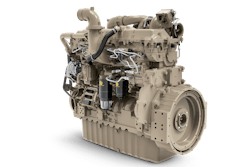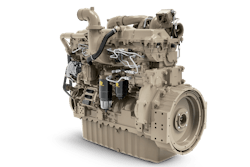
Our team was happy to talk with Nick Block, director, global marketing and sales, John Deere Power Systems
about our industry in 2022 and what to expect heading into 2023.
What was your biggest challenge in 2022?
The power industry is transitioning its focus to more sustainable alternatives to diesel as well as increased regulation. As emission regulations become stricter and there are more sustainability requirements for project bids and contracts, customers are looking for solutions that can help them future proof their equipment operations in the face of these demands.
John Deere is committed to providing our customers with the highest-quality, most durable and efficient powertrain technologies at the lowest possible cost. To do that, we are taking a holistic, diversified approach to powertrain solutions by making strategic investments in electrification, alternative fuels, and other future-forward technologies that will give original equipment manufacturers (OEMs) and their customers a competitive edge in the off-highway market as they work to meet their productivity and sustainability goals.
In what technological areas do you see the potential for the most innovation?
As owners and operators of off-highway equipment continue to face increasing demands for lowering their carbon footprint, fuel economy, and productivity, we are seeing advancements in electrification, integrating alternative fuel technologies, and continued efficiency improvements to diesel engines. I think we’ll see more innovation in these technological areas as the industry continues its transition to alternative power solutions beyond just natural gas and diesel.
Battery power has various advantages to offer that OEMs are taking notice of; and while we are still in the early stages of adoption in the off-highway industry, there is already a lot of promising technology out there.
To help with integrating vehicle and powertrain designs around battery packs, John Deere has acquired majority ownership in Kreisel Electric (Kreisel), a battery technology provider based in Austria. Kreisel develops high-durability electric battery modules and packs as well as a charging infrastructure platform—CHIMERO—that utilizes this patented battery technology. As a leader in cutting-edge battery products engineered specifically for off-road industries, Kreisel is uniquely equipped to provide solutions that are safer and offer superior performance and a longer lifetime. Our strategic relationship with Kreisel will serve as the cornerstone in electrifying our product portfolio as we strive to provide fully electric and hybrid solutions for the off-highway electrification market.
Advancements in electrification are also paving the way for hybrid engine and drivetrain components. A recent hybrid innovation at John Deere is our Electric Variable Transmission (EVT) technology, which has been incorporated into select models of our agricultural and road building machinery. John Deere is leading the charge in the adoption of EVT technology in the off-highway industry. Our EVT incorporates electric motor generators in place of the usual hydrostatic motors, resulting in improved transmission performance, reliability, and increased efficiency. The motor generators enable electric power to be generated, resulting in new opportunities to power implements and attachments.
While developments in electrification and alternative fuels are helping to expand sustainable power solutions for the off-highway industry, there are still applications where diesel power will continue to make sense.
As the industry continues to use diesel power, advancements in diesel technology are helping optimize internal combustion engines to meet changing emissions regulations across the globe. For example, our next generation engines leverage the best technologies of John Deere in new ways to deliver new levels of reliability, durability, flexibility, and serviceability for a wide array of heavy-duty applications.
The next generation engines are designed for easy integration and offer simple maintenance so users can stay on the job longer. They also provide operators with lower operating costs and meet U.S. EPA Final Tier 4/Stage V emissions regulations. Our next generation engine lineup includes the JD4, JD14, and JD18. With this expanded power range, owners and operators can put John Deere power and performance into their entire lineup of equipment, from 36 kW (48 hp) to 677 kW (908 hp). We continue to look at ways to further improve the efficiency of our next generation engines to reduce fuel consumption and improve performance.
What innovations or improvements do you anticipate in the off-highway industry in 2023?
Changes to emissions regulations are highlighting the need for diversified powertrain solutions that can meet power requirements across a range of vehicle and equipment sizes. Customers are looking for power solutions that can help their equipment operation meet these increasingly stringent emissions requirements while also bolstering their productivity and uptime. As we look ahead to 2023, I think we’ll see further developments in electrification and the integration of alternative fuels.
Future emissions regulations are likely to push the cost of an internal combustion engine (ICE) vehicle to a point where it could be more cost-effective to have a battery-electric vehicle. That’s particularly true with smaller equipment where the total cost of ownership is already at or below the cost of an ICE vehicle.
I anticipate that, over the next several years, customers will increasingly adopt battery-powered machines as we continue to see advancements in battery technology, the development of charging infrastructure, and battery-electric vehicle costs reaching parity with ICE vehicles.
As for developments with alternative fuels, petroleum-based fuels have been the industry standard for years primarily due to the lack of acceptable, cost-effective and reliable alternatives. However, with growing interest in sustainable energy, alternative fuels are becoming more widely adopted and readily available.
John Deere is committed to bringing the most advanced, affordable, and effective alternative fuel solutions to end users. With world-class engineering expertise, we’re simplifying the integration of alternative fuels with combustion engines to deliver more value and productivity. To support our goal of providing differentiated powertrain solutions, we’ve made an equity investment in ClearFlame Engine Technologies, a Chicago-based start-up dedicated to the development of clean engine technology.
We've also ensured that today’s engines have compatibility with renewable diesel fuel like hydrogenated vegetable oil (HVO), which is a biofuel made by the hydrocracking or hydrogenation of vegetable oil. Renewable diesel offers a sustainable replacement comparable to diesel fuel.
Which industries face the most hurdles in the move toward electrification? Automation?
John Deere sees demand growing for batteries as a sole or hybrid propulsion system for off-highway vehicles. Some of electrification’s earliest adopters will be applications where equipment could rely solely on batteries as a primary power source. These include turf equipment, compact utility tractors, small tractors, compact construction equipment, and some road building equipment. The requirements for battery technology will differ greatly by vehicle segment. The industries that will face the most hurdles in the move toward electrification will be heavy-duty construction, forestry, and agriculture.
Off-road battery applications are more demanding than on-road and require higher energy density, durability, thermal management, and integrated software to match the duty cycle of a given job. Even in the face of these tough conditions, however, advancements in battery power technology are positioning batteries to be a viable long-term power solution for heavy equipment.
What will be the biggest challenge in 2023 for the industry?
As we continue to see advancements in electrification over the next year, I believe the industry will have to navigate the challenges of managing customer expectations when it comes to battery power. Since the introduction of battery technology to the off-highway market, range and run time have been concerns. As more OEMs look to integrate battery power into their equipment, proper sizing and power density packaging will be critical. With better understanding of how applications are being used and of customers' expectations, power solutions providers and OEMs will be able to find paths to meet and even exceed those expectations.
Having a skilled battery technology provider as a partner who can help develop different voltage-level solutions will help set OEMs up to successfully and efficiently scale power needs for different applications.
Check out the full report.




















